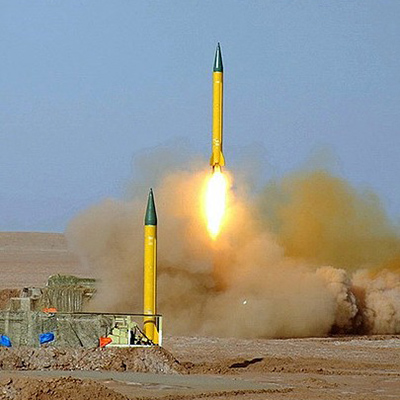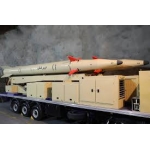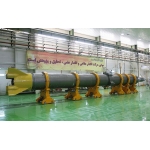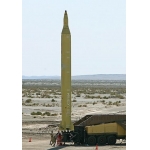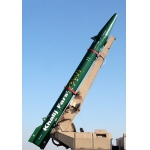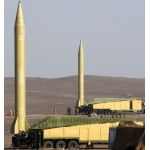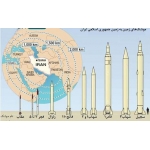Warfare
Missile
Mohsen Shir-Muhammad
86 دورہ
During the Iraq-Iran War, both sides used various types of missiles to destroy ground, air, and naval targets. However, sanctions imposed on Iran and, conversely, the comprehensive support provided for Iraq by the major powers, enabled the latter to use much more missiles. A missile is a self-guided vehicle that operates without the need for human control and carries a warhead containing explosive materials. Missiles generate their propulsion force independently without requiring external power and are equipped with different guidance and control systems to accurately deliver the warhead to the target. Typically, military missiles have warheads containing chemical or nuclear explosives, while non-military models carry research equipment such as exploration, communication, meteorological, or navigation satellites. Missiles usually require supporting equipment for launch, such as platforms or launchers and transportation equipment, which are considered support systems for ground, naval, or air missiles. The combination of a missile and the equipment involved in its launch is referred to as the missile system.[1]
In terms of types, a missile launched from the ground against fixed or moving targets is called ground-to-ground; a missile launched from the ground against air targets is called ground-to-air; a missile launched from the air against ground or naval surface targets is called air-to-surface; and a missile launched from the air via an aircraft against air targets is called air-to-air.[2]
Various missile systems were employed during the eight-year Iraq-Iran War.[3] Regarding ground-to-ground missiles, Iraq’s first attack on October 8, 1980, involved launching four Frog missiles at residential areas of Dezful.[4] The Frog missile, made by the Soviet Union, has a range of 65 kilometers. However, due to its inaccuracy, it was used against cities and populated areas to ensure a hit under any circumstances.[5] On October 26, 1982, Iraq attacked Dezful with a Scud missile (B model).[6] The Scud-B has a range of 290 to 300 kilometers.[7] At the start of the war, Iraq had eight Scud missile launchers organized in one regiment[8] and 26 Frog launch platforms.[9]
Iran had no ground-to-ground missiles until 1984[10] when the country managed to acquire one Scud-B missile launch platform along with 30 of these missiles from Libya.[11] In 1986, Iran also began launching the Oqab missile. Oqab was developed by Iran based on the Chinese “Model-82” missile.[12] With a 70-kilogram warhead and a 40-kilometer range, the Oqab lacked high accuracy and was only suitable for targeting large objectives. Iran could fire this missile at Iraqi cities near the border, such as Basra.[13]
In the final year of the war, Iraq conducted heavy missile attacks to weaken the morale of the Iranian people.[14] In total, Iraq fired 82 Frog missiles, 175 Scud missiles, and 153 al-Hussain missiles (a modified Scud variant), while Iran launched 326 Oqab and 119 Scud missiles over the eight years of the war.[15]
Regarding anti-tank missiles in the Iran-Iraq War, Iran used TOW and Dragon missiles (made in the US) and French SS-11 and SS-12 missiles as anti-tank weapons. TOW missiles, launched from both vehicles and Cobra helicopters, proved highly effective in destroying Iraqi tanks.[16] Iran later used Sagger missiles (made in the Soviet Union) as well,[17] whereas Iraq was equipped with both Milan (made in France) and Sagger missiles. However, only one out of every 20 to 30 Sagger missiles would hit its target.[18]
The Iranian warships were equipped with Sea Killer missiles (made in Italy) and Harpoon missiles (made in the US),[19] and the Iraqi missile boats used Styx missiles (made in the Soviet Union).[20] Iraq also used Silkworm missiles (made in China) to target ships heading to Imam Khomeini (ra) Port in order to close off the Musa Channel.[21] The Silkworm had an effective range of 70 to 80 kilometers.[22] In 1986, Iran acquired 50 to 70 Silkworm missiles and 12 launch platforms.[23] On December 15, 1986, the first shore-to-sea missile of the Islamic Revolutionary Guard Corps (IRGC) was fired at the al-Bakr Wharf.[24] In 1987, al-Ahmadi and Shuaiba platforms in Kuwait were targeted by Iran’s Silkworm missiles because Kuwait had backed Iraq.[25]
Regarding ground-to-air missiles, Iran was equipped with Seacat, Tigercat, Rapier (all made in the UK), Hawk (made in the US)[26], and SAM-7 missiles[27] (made in the Soviet Union). The 33 Hawk fire units,[28] known in Iran as “Hag”, were among the most important defensive weapons during the war and widely used against enemy air strikes.[29] For example, during Operation Valfajr 8 (the capture of Faw), 72 Iraqi aircraft were shot down by Hag missiles.[30] However, while the Hawk was effective for targeting aircraft at medium altitudes, it was incapable of engaging high-altitude targets such as the MiG-25.[31] Therefore, in 1984, Iran received the SAM-2 anti-aircraft missile system (made in the Soviet Union) through Libya,[32] and in 1986, the HQ-2 anti-aircraft missile system (made in China) was delivered to Iran.[33] One notable action of the HQ-2 system was the downing of a MiG-25 in Isfahan on February 15, 1986.[34]
In the early days of the war, Iraq relied heavily on SAM-2, SAM-3, and SAM-6 ground-to-air missiles for air defense. In 1981, it also received 30 Crotale missile fire units from France.[35] On the other had, Iraq deployed heavy and semi-heavy SAM missile fire units to counter aircraft flying at medium to high altitudes. Iraq followed Soviet military tactics and formations, relying solely on Soviet guidelines for the use of SAM missiles rather than adapting them to its own needs.[36] By the end of the war in 1988, Iraq had continued to develop its missile defense, possessing 120 SAM-2, 150 SAM-3, 250 SAM-6, and 60 Roland missile launch systems.[37]
Regarding air-to-surface missiles in the Iran-Iraq War, Iran’s F-4 aircraft were equipped with Maverick air-to-ground missiles.[38] During Operation Morvarid (November 28, 1980), Iraqi missile boats were targeted and sunk by Maverick missiles fired from Iranian Phantoms.[39] Moreover, the Iranian military experts managed to equip Cobra helicopters (Army Aviation) and SH-3D helicopters (Naval Aviation) with Maverick missiles.[40] Iraq also used Exocet missiles against Iran. At the beginning of the war, Super Frelon helicopters were employed to fire these missiles at ships in the Musa Channel and Imam Khomeini (ra) Port.[41] Later, Exocet missiles were used by Iraq’s Super Étendard aircraft.[42] From 1985, Iraq’s Mirage aircraft also were armed with Exocet missiles.[43] During the war, Iran began using reflectors (radar wave deflectors) to counter the guidance systems of Exocet missiles.[44] By installing reflectors on boats, Iran would send misleading signals to Exocet missiles.[45] In total, from 1980 to 1987, Iraq received 734 Exocet missiles from France,[46] of which were fired on ships through 257 attacks.[47] Iraq also used AS-3, AS-4, and AS-14 missiles as the air-to-ground missiles[48] and KH-28 missiles (all made in the Soviet Union) as anti-radar weapons. For instance, a KH-28 missile targeted and destroyed the radar of the Iranian Hawk missile site.[49]
In terms of air-to-air weapons, Iraq equipped its Russian aircraft with Atoll missiles, including AA-6, AA-7, and AA-8 models. The Iraqi Mirage aircraft also used French-made Majic missiles, including the R-530, R-550, and Super 530 models. The Super 530, with a range of 35 kilometers, was comparable to the best radar-guided missiles made in the United States.[50]
Iranian aircraft, such as the F-14, were equipped with Sidewinder (AIM-9), Sparrow (AIM-7), and Phoenix (AIM-54) missiles.[51] The radar-guided, long-range Phoenix missile (exclusive to the F-14) played a significant role in defending Iran’s airspace.[52] At the beginning of the war, only locking onto Iraqi fighter jets with the F-14’s radar (equipped with Phoenix missiles) was enough to make them retreat.[53] During the war, the Iranian aircraft, with greater fuel capacity and operational range, could shut down the Iraqi ones with AIM-9 (Sidewinder) missiles.[54] However, after 1982, Iraq gained air superiority by using French aircraft and missiles.[55]
After the end of the Iran-Iraq War, Iran began producing various types of ground-to-ground missiles, including Sejjil, Fateh, and Shahab, as well as anti-tank ones such as Toofan, Raad, and Saeqe. In addition, anti-ship missiles like Noor, Kowsar, Qader, and Zafar, air-to-ground missiles such as Shafaq, Shahin-3, Sattar, and Asr-67, air-to-air missiles like Sejjil and Fater,[56] and anti-aircraft missiles including Sayyad, Bavar-273, and Taer are among Iran’s other domestically produced missiles.[57]
[1] Aslani, Yaqub, Tarikheche-ye Mushaki-ye Iran (A Brief History of Iran’s Missile Program), Mahname-ye Saf, No. 351, Dey 1388, p. 12.
[2] Rostami, Mahmoud, Farhang-e Vajehhaye Nezami (Dictionary of Military Terms), Tehran, Setad-e Moshtarak Artesh-e Jomhouri-ye Eslami-ye Iran, 1378, Pp. 800–802.
[3] Cordesman, Anthony va Abraham Wagner, Dars-haye Jang-e Modern – Jang-e Iran va Araq (Lessons of Modern War – Iran-Iraq War), Vol. 2, trans. Hussain Yekta, Tehran, Marzoboom, 1390, p. 375.
[4] Alaei, Hussain, Ravand-e Jang-e Iran va Araq (The Course of the Iran-Iraq War), Vol. 1, Tehran, Marzoboom, 1391, p. 228.
[5] Ibid.
[6] Saleminejad, Abdolreza, Dezful – Gozareshi az Shahr-e Moqavem Dezful dar Jang-e Shahrha 1359–1367 (Dezful – Report on the Resistant City of Dezful During the Cities War), Tehran, Markaz-e Asnad va Tahqiqat-e Defa Muqaddas, 1397, p. 155.
[7] Cordesman, Anthony va Abraham Wagner, Dars-haye Jang-e Modern – Jang-e Iran va Araq (Lessons of Modern War – Iran-Iraq War), Vol. 2, p. 446.
[8] Ibid., Vol. 1, trans. Hussain Yekta, Tehran, Marzoboom, 1390, p. 365.
[9] Ibid., p. 157.
[10] Ibid., Vol. 2, p. 444.
[11] Alaei, Hussain, Ravand-e Jang-e Iran va Araq (The Course of the Iran-Iraq War), Vol. 2, Tehran, Marzoboom, 1391, Pp. 82, 83.
[12] Cordesman, Anthony va Abraham Wagner, Dars-haye Jang-e Modern – Jang-e Iran va Araq (Lessons of Modern War – Iran-Iraq War), Vol. 1, p. 445.
[13] Ibid., Vol. 2, Pp. 206, 486.
[14] Ibid., p. 377.
[15] Asadi, Heybatollah, Atash-e Tophkhaneh (Artillery Fire), Tehran, Dafos-e AJA, 1394, Pp. 394, 395.
[16] Cordesman, Anthony va Abraham Wagner, Dars-haye Jang-e Modern – Jang-e Iran va Araq (Lessons of Modern War – Iran-Iraq War), Vol. 2, Pp. 344, 345.
[17] Ibid., p. 346.
[18] Ibid., Pp. 346, 347.
[19] Manavi Roodasari, Abdollah, Negahi be Niru-ye Daryayi Artesh-e Jomhouri-ye Eslami-ye Iran dar Hasht Saal-e Defa Muqaddas (An Overview of the Iranian Army Navy during the Eight Years of Sacred Defense), Tehran, Iran Sabz, 1397, Pp. 55, 57.
[20] Ibid., p. 68.
[21] Cordesman, Anthony va Abraham Wagner, Dars-haye Jang-e Modern – Jang-e Iran va Araq (Lessons of Modern War – Iran-Iraq War), Vol. 1, p. 215.
[22] Ibid., Vol. 2, p. 38.
[23] Ibid., p. 141.
[24] Alaei, Hussain, Ravand-e Jang-e Iran va Araq (The Course of the Iran-Iraq War), Vol. 2, p. 277.
[25] Niru-ye Daryayi-ye Sepah Chegooneh Tashkil Shod (How was the IRGC Navy Formed), Khabargozari-ye Defa Muqaddas, 26 Shahrivar 1399.
[26] Arasteh, Naser, Maaref-e Jang (War Studies), Tehran, Entesharat-e Iran Sabz, 1393, p. 362.
[27] Azghandi, Alireza, Ravabet-e Khareji-ye Iran 1320–1357 (Iran’s Foreign Relations, 1941–1979), Tehran, Qoomes, 1376, p. 324.
[28] Gholami, Baratali, Padafand-e Havayi – Sir-e Towseeh va Takamol (Air Defense – Path of Development and Evolution), Vol. 1, Tehran, Iran Sabz, 1399, p. 81.
[29] Aslani, Yaqub, Raket va Mushakhha-ye Estrategik-e Jahan – Mushakhha-ye Satah be Hava (Strategic Missiles of the World – Surface-to-Air Missiles), Vol. 6, Tehran, Sazman-e Aqidati-Siasi Artesh, 1380, p. 33.
[30] Zahedi Motlaq, Ebrahim, Shelik be Aseman (Firing at the Sky), Tehran, Sura Mehr, 1396, p. 246.
[31] Cordesman, Anthony va Abraham Wagner, Dars-haye Jang-e Modern – Jang-e Iran va Araq (Lessons of Modern War – Iran-Iraq War), Vol. 2, p. 383.
[32] Ahmadi, Muhammad-Ali, Atlas-e Padafand-e Havayi-ye Sepah dar Doran-e Defa Muqaddas (IRGC Air Defense Atlas During the Sacred Defense), Tehran, Markaz-e Asnad va Tahqiqat-e Defa Muqaddas, 1400, p. 178.
[33] Ibid., Pp. 182, 184.
[34] Ibid., p. 190.
[35] Cordesman, Anthony va Abraham Wagner, Dars-haye Jang-e Modern – Jang-e Iran va Araq (Lessons of Modern War – Iran-Iraq War), Vol. 2, p. 381.
[36] Ibid., p. 382.
[37] Ibid., p. 381.
[38] Zeynali, Nasrollah, Amad va Poshtibani Havayi dar Defa Muqaddas – Az Aghaz ta Shorou-e Jang-e Tahmili (Air Logistical Support during the Sacred Defense – From the Beginning to the Outbreak of War), Vol. 1, Tehran, Markaz-e Entesharat-e Rahbordi-ye Nahaja, 1394, p. 296.
[39] Masbooq, Muhammad va Alireza Javaheri, Amaliat-e Morvarid (Operation Morvarid), Tehran, Markaz-e Entesharat-e Rahbordi-ye Nahaja, 1394, Pp. 114–131.
[40] Shirmuhammad, Mohsen, Bar Faraz-e Darya-ha – Negahi be Tarikh-e Havadarya va Hamaase-ye Eskadron-ha-ye Havanav, Balgard va Bal-e Sabet dar Jang-e Tahmili (Over the Seas – A Glance at the History of Naval Aviation and the Heroism of Hovercraft, Helicopter, and Fixed-Wing Squadrons in the Imposed War), Tehran, Daftar-e Pajouhesh-haye Nazari va Motaleat-e Rahbordi-ye Nedaja, 1400, Pp. 193, 194.
[41] Ibid., p. 229.
[42] Cordesman, Anthony va Abraham Wagner, Dars-haye Jang-e Modern – Jang-e Iran va Araq (Lessons of Modern War – Iran-Iraq War), Vol. 2, p. 502.
[43] Ibid., p. 403.
[44] Woods, Kevin M. va Digaran, Jang-e Iran va Araq az Didgah-e Farmandehan-e Saddam (The Iran-Iraq War from Saddam’s Commanders’ Viewpoint), trans. Abdolhamid Heidari, Tehran, Nashr-e Marzoboom, 1393, p. 349.
[45] Ibid., p. 350.
[46] Navias, Martin S. va E. R. Hooton, Jang-e Naftkeshha (The Tanker War), trans. Pejman Pourjabari va Rahmat Qareh, Tehran, Bonyad-e Hefz-e Asar va Nashr-e Arzeshha-ye Defa Muqaddas, 1392, p. 169.
[47] Ibid., p. 15.
[48] Cordesman, Anthony va Abraham Wagner, Dars-haye Jang-e Modern – Jang-e Iran va Araq (Lessons of Modern War – Iran-Iraq War), Vol. 2, Pp. 397, 406.
[49] Namaki, Alireza, Niru-ye Havayi dar Defa Muqaddas (The Air Force in the Sacred Defense), Tehran, Iran Sabz, 1389, p. 220.
[50] Cordesman, Anthony va Abraham Wagner, Dars-haye Jang-e Modern – Jang-e Iran va Araq (Lessons of Modern War – Iran-Iraq War), Vol. 2, Pp. 401, 404, 405.
[51] Ibid., p. 409.
[52] Kareshki, Muhammad-Reza, Be Su-ye Qolleha (Towards the Peak), Tehran, AJA, 1393, p. 254.
[53] Moamma, Muhammad, Nabard dar Aseman (Battle in the Sky), Tehran, Ketab-e Yousef, 1389, Pp. 76, 77.
[54] Cordesman, Anthony va Abraham Wagner, Dars-haye Jang-e Modern – Jang-e Iran va Araq (Lessons of Modern War – Iran-Iraq War), Vol. 2, p. 413.
[55] Ibid., Pp. 413, 414.
[56] Hame-ye Mushakhha-ye Iran; az Mafoqe Soot-ha ta Mushakhha-ye Qareh Peyma (All of Iran’s Missiles; from Hypersonic to Intercontinental Ballistic Missiles), Mehr News Agency, 23 Azar.
[57] Mushakhha-ye Padafandi-ye Iran az Marzhaye Enhesari-ye Qodrathaye Mashhoor Gozashtand (Iran’s Air Defense Missiles Overcame the Global Powers), Mashreq News, 21 Tir 1401.




